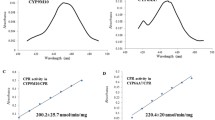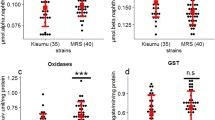Abstract
The widespread use of synthetic insecticides has resulted in the development of insecticide resistance among disease mosquito vector. Resistance development involves several genes, including CYP450 and esterase family genes. In the current study, expression profiles of seven CYP450 genes namely, CYP9M10, CYP9J40, CYP6AA7, CYP9J34, CYTP450 B9, CYP6M2, CYP6Z2 and three esterase genes namely, esterase β1, alpha esterase, KM234962 were investigated in temephos resistant and susceptible in larvae. The third instar larvae of An. stephensi were subjected to insecticide selection with temephos (Tem Res) following the WHO protocol. Our results show CYP6M2,CYP6Z2 and alpha esterase genes are prominent in temephos resistant in larvae. We suggest that P450 genes and esterase genes, α-esterase and esterase β1 are mostly involved in temephos resistance in larval stage. These results suggest that metabolic resistance may be more prevalent in larval mosquito and play an important role in temephos resistance.



Similar content being viewed by others
References
Aïzoun N, Aïkpon R, Padonou GG, Oussou O, Oké-Agbo F, Gnanguenon V (2013) Mixed-function oxidases and esterases associated with permethrin, deltamethrin and bendiocarb resistance in Anopheles gambiae s.l. in the south-north transect Benin, West Africa. Paras Vec 6:223
Araújo AP, Diniz DFA, Helvecio E, De Barros RA, De Oliveira CMF, Ayres CFJ (2013) The susceptibility of Aedes aegypti populations displaying temephos resistance to Bacillus thuringiensis israelensis: a basis for management. Parasit Vectors 6(1):297
Chareonviriyaphap T, Bangs MJ, Suwonkerd W, Kongmee M, Corbel V, Ngoen-Klan R (2013) Review of insecticide resistance and behavioral avoidance of vectors of human diseases in Thailand. Parasit Vectors 6:280
Claudianos C, Ranson H, Johnson R, Biswas S, Schuler MA, Berenbaum MR (2006) A deficit of detoxification enzymes: Pesticide sensitivity and environmental response in the honeybee. Insect Mol Biol 15:615–636
David J-P, Ismail HM, Chandor-Proust A, Paine MJIJPTotRSBBS, (2013) Role of cytochrome P450s in insecticide resistance: Impact on the control of mosquito-borne diseases and use of insecticides on Earth. Philosophical Transactions of the Royal Society B: Biological Sciences 368:20120429
David J-P, Strode C, Vontas J, Nikou D, Vaughan A, Pignatelli PM (2005) The Anopheles gambiae detoxification chip: A highly specific microarray to study metabolic-based insecticide resistance in malaria vectors. Proc Natl Acad Sci 102:4080–4084
Djouaka RF, Bakare AA, Coulibaly ON, Akogbeto MC, Ranson H, Hemingway J (2008) Expression of the cytochrome P450s, CYP6P3 and CYP6M2 are significantly elevated in multiple pyrethroid resistant populations of Anopheles gambiae ss. from Southern Benin and Nigeria. 9:538
Donnelly MJ, Corbel V, Weetman D, Wilding CS, Williamson MS, Black IV, WCJTip (2009) Does kdr genotype predict insecticide-resistance phenotype in mosquitoes? Trends in parasitol 25:213–219
Feyereisen R (2006) Evolution of insect P450. Biochem Soc Trans 34:1252–1255
Gui Z, Hou C, Liu T, Qin G, Li M, Jin B (2009) Effects of Insect Viruses and Pesticides on Glutathione S-Transferase Activity and Gene Expression in Bombyx mori. J Econ Entomol 102:1591–1598
Hemingway J, Ranson HJAroe, (2000) Insecticide resistance in insect vectors of human disease. Annu Rev Entomol 45:371–391
Jirakanjanakit N, Saengtharatip S, Rongnoparut P, Duchon S, Bellec C, Yoksan SJEe (2014) Trend of temephos resistance in Aedes (Stegomyia) mosquitoes in Thailand during 2003–2005. Env entomol 36:506–511
Kasai S, Weerashinghe IS, Shono TJAoIB and America PPiCwtESo (1998) P450 monooxygenases are an important mechanism of permethrin resistance in Culex quinquefasciatus Say larvae. Published in Collaboration with the Entomological Society of America 37(1):47–56
Kostaropoulos I, Papadopoulos AI, Metaxakis A, Boukouvala E, Papadopoulou-Mourkidou E (2001a) Glutathione S–transferase in the defence against pyrethroids in insects. Insect Biochem Mol Biol 31:313–319
Kostaropoulos I, Papadopoulos AI, Metaxakis A, Boukouvala E, Papadopoulou-Mourkidou E (2001b) The role of glutathione S-transferases in the detoxification of some organophosphorus insecticides in larvae and pupae of the yellow mealworm, Tenebrio molitor (Coleoptera: Tenebrionidae). Pest Manag Sci 57:501–508
Kweka E, Mahande A, Ouma J, Karanja W, Msangi S, Temba V (2018) Novel Indoor Residual Spray Insecticide With Extended Mortality Effect: A Case of SumiShield 50WG Against Wild Resistant Populations of Anopheles arabiensis in Northern Tanzania. Global Health: Sci Prac 6:758
Lagadic L, Cuany A, Bergé J-B, Echaubard MJIb and biology M (1993) Purification and partial characterization of glutathione S-transferases from insecticide-resistant and lindane-induced susceptible Spodoptera littoralis (Boisd.) larvae. Insect Biochem Mol Biol 23:467–474
Lees R, Praulins G, Davies R, Brown F, Parsons G, White A (2019) A testing cascade to identify repurposed insecticides for next-generation vector control tools: Screening a panel of chemistries with novel modes of action against a malaria vector. Gates Open Research, 3
Lumjuan N, Rajatileka S, Changsom D, Wicheer J, Leelapat P, Prapanthadara LA (2011) The role of the Aedes aegypti Epsilon glutathione transferases in conferring resistance to DDT and pyrethroid insecticides. Insect Biochem Mol Biol 41:203–209
Mahande A, Dusfour I, Matias J, Kweka E (2012) Knockdown resistance, Rdl alleles, and the annual entomological Inoculation rate of wild mosquito populations from Lower Moshi. Northern Tanzania J Global Inf Dis 4:114
Marcombe S, Fustec B, Cattel J, Chonephetsarath S, Thammavong P, Phommavanh N (2019) Distribution of insecticide resistance and mechanisms involved in the arbovirus vector Aedes aegypti in Laos and implication for vector control. PLoS Neglected Tropical Dis 13:e0007852
Martins AJ, Bellinato DF, Peixoto AA, Valle D, Lima JBPJPo (2012) Effect of insecticide resistance on development, longevity and reproduction of field or laboratory selected Aedes aegypti populations. PLoS One 7(3):e31889
Matowo J, Jones CM, Kabula B, Ranson H, Steen K, Mosha F (2014) Genetic basis of pyrethroid resistance in a population of Anopheles arabiensis, the primary malaria vector in Lower Moshi, north-eastern Tanzania. Parasit Vectors 7:274
Matowo J, Kulkarni MA, Mosha FW, Oxborough RM, Kitau JA, Tenu F (2010) Biochemical basis of permethrin resistance in Anopheles arabiensis from Lower Moshi, north-eastern Tanzania. Malaria J 9:193
Mbepera S, Nkwengulila G, Peter R, Mausa EA, Mahande AM, Coetzee M (2017) The influence of age on insecticide susceptibility of Anopheles arabiensis during dry and rainy seasons in rice irrigation schemes of Northern Tanzania. Malaria J 16:364
Mitchell SN, Stevenson BJ, Müller P, Wilding CS, Egyir-Yawson A, Field SG (2012) Identification and validation of a gene causing cross-resistance between insecticide classes in Anopheles gambiae from Ghana. Proc Natl Acad Sci 109:6147–6152
Mueller P, Chouaibou M, Pignatelli P, Etang J, Walker ED, Donnelly MJ (2008) Pyrethroid tolerance is associated with elevated expression of antioxidants and agricultural practice in Anopheles arabiensis sampled from an area of cotton fields in Northern Cameroon. Mol Ecol 17:1145–1155
Rault LC, Johnson EJ, O’Neal ST, Chen R, McComic SE, Swale DR (2019) Age- and sex-related ABC transporter expression in pyrethroid-susceptible and –resistant Aedes aegypti. Sci Rep 9:19551
Somwang P, Yanola J, Suwan W, Walton C, Lumjuan N, Prapanthadara LA (2011) Enzymes-based resistant mechanism in pyrethroid resistant and susceptible Aedes aegypti strains from northern Thailand. Parasitol Res 109:531–537
Tene BF, Poupardin R, Costantini C, Awono-Ambene P, Wondji CS, Ranson H, Antonio-Nkondjio C (2013) Resistance to DDT in an urban setting: common mechanisms implicated in both M and S forms of Anopheles gambiae in the city of Yaoundé Cameroon. PloS One 8(4):e61408
Terriere LCJARoE (1984) Induction of detoxication enzymes in insects. Annu Rev Entomol 29:71–88
Vivekanandhan P, Bedini S, Shivakumar MS (2020) Isolation and identification of entomopathogenic fungus from Eastern Ghats of South Indian forest soil and their efficacy as biopesticide for mosquito control. Parasitol Int 76:102099
Vontas JG, Graham J, Hemingway JJBJ (2001) Glutathione S-transferases as antioxidant defence agents confer pyrethroid resistance in Nilaparvata lugens. Biochem J 357:65–72
Vontas JG, Graham J, Nikou DC, Ranson H, Hemingway JJBJ (2002) Purification, molecular cloning and heterologous expression of a glutathione S-transferase involved in insecticide resistance from the rice brown planthopper, Nilaparvata lugens. Biochem J 362:329–337
Vulule J, Beach R, Atieli F, McAllister J, Brogdon W, Roberts J (1999) Elevated oxidase and esterase levels associated with permethrin tolerance in Anopheles gambiae from Kenyan villages using permethrin impregnated nets. Med Vet Entomol 13:239–244
Wang MH, Marinotti O, Zhong D, James AA, Walker E, Guda T (2013) Gene Expression-Based Biomarkers for Anopheles gambiae Age Grading. PLoS One 8:e69439
Wei S, Clark A, Syvanen MJIb and biology M (2001) Identification and cloning of a key insecticide-metabolizing glutathione S-transferase (MdGST-6A) from a hyper insecticide-resistant strain of the housefly Musca domestica. Insect Biochem Mol Biol 31:1145–1153
WHO (2005) Guidelines for laboratory and field testing of mosquito larvicides. World Health Organization, WHO/HQ-Geneva
WHO (2012) Global plan for insecticide resistance management in malaria vectors. World Health Organisation, Geneva
Wilding CS, Smith I, Lynd A, Yawson AE, Weetman D, Paine MJ (2012) A cis-regulatory sequence driving metabolic insecticide resistance in mosquitoes: functional characterisation and signatures of selection. Insect Biochem Mol Biol 42(9):699–707
Yewhalaw D, Kweka EJ (2016) Insecticide resistance in East Africa—history, distribution and drawbacks on malaria vectors and disease control. In Insecticides resistance, ed. by Trdan S. Rijeka: Intech: Russia, pp. 189-215
Zhang Y, Zhang B, Yan D, Dong W, Yang W, Li Q (2011) Two Arabidopsis cytochrome P450 monooxygenases, CYP714A1 and CYP714A2, function redundantly in plant development through gibberellin deactivation. The Plant J 67:342–353
Zhu F, Feng JN, Zhang L, Liu NJImb (2008) Characterization of two novel cytochrome P450 genes in insecticide resistant house flies. Insect Mol Biol 17:27–37
Zhu F, NJAoIB & America PPiCwtESo (2008) Differential expression of CYP6A5 and CYP6A5v2 in pyrethroid resistant house flies, Musca domestica. Archives of Insect Biochem Physiol: Published in Collaboration with the Entomological Society of America 67:107–119
Acknowledgements
We also thank the Department of Zoology, Periyar University, Salem, Tamil Nadu, India, for providing the infrastructural facility for carrying out this research.
Author information
Authors and Affiliations
Corresponding author
Ethics declarations
Ethical statement
The present research does not have any evaluation/test in humans performed by any of the authors contains this article. We followed all national, international guidelines for the use of target and non-target organisms were followed.
Conflicts of interest
The authors declare that they do not have any conflict of interest.
Rights and permissions
About this article
Cite this article
Vivekanandhan, P., Thendralmanikandan, A., Kweka, E.J. et al. Resistance to temephos in Anopheles stephensi larvae is associated with increased cytochrome P450 and α-esterase genes overexpression. Int J Trop Insect Sci 41, 2543–2548 (2021). https://doi.org/10.1007/s42690-021-00434-6
Received:
Accepted:
Published:
Issue Date:
DOI: https://doi.org/10.1007/s42690-021-00434-6




